All members of Minnesota's Greatest Generation who served their country during World War II spent at least part of the war stateside. For most, this time was spent in the training required for their branch of service prior to transport overseas. Some continued on as instructors or in office positions at U.S. military bases, others were assigned as medical personnel to stateside hospitals.
While some women who joined the newly formed women's auxiliary corps in the Army, Navy or Coast Guard, or who became women Marines, were sent overseas, many were placed in stateside jobs that would free up men to fight. Some received officer training. Women Airforce Service Pilots ferried military planes from one base to another. Others handled a wide variety of office duties, trained to become radiomen at air bases, or were drivers in motor pools.
A special group of Japanese-American soldiers, many from Hawaii and the Pacific coast, would find themselves facing Minnesota winters as they trained for the role of interpreters and code breakers at the Military Intelligence Service Language School, located first at Camp Savage and, later, at Fort Snelling. These young men, the children of Japanese immigrants who were retained by the U.S. government in internment camps in the western U.S., worked for their country in an important role in the Pacific Theater of Operations and in the post-war occupation of Japan.
Some 1,000 Minnesotans found themselves assigned to another type of service role: working on the top secret "Manhattan Project," carried out in laboratories around the country. It was only when the atomic bombs - the fruits of their labors - were dropped on Japan in August 1945 - that they would understand the tangible effect their work would have on ending the war.
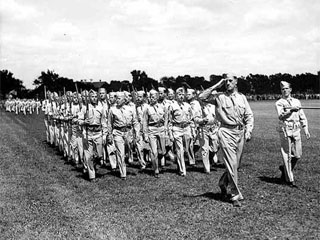
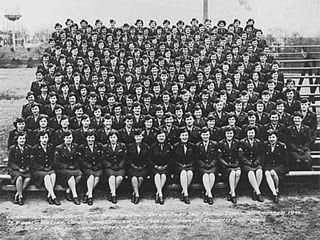
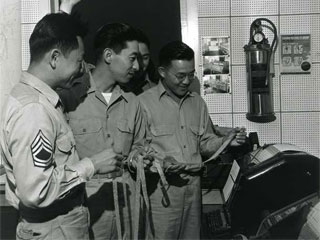

Secret Japanese Language School
The Japanese-American population living on the Pacific coast after the bombing of Pearl Harbor were subjected to unfair treatment grounded in fear and suspicion. The government's mistrust of those of Japanese ethnicity resulted in an order in 1942 that forced whole families to abandon homes and businesses and report to relocation centers where they would await resettlement outside the Pacific coastal region. An estimated 116,500 Issei, Nisei, Kibei, and Sansei were interned in this way.
Young Japanese-American men were excluded from active military service until early in 1943 when the volunteer 100th Infantry Battalion of Hawaii paved the way for the formation of the 442nd Japanese-American combat unit - a unit that served with distinction throughout the war.
The military found another way in which the Nisei could serve their country: that of intelligence linguists. As relations with Japan deteriorated before Pearl Harbor, the Army realized the necessity of having capable interpreters to translate intercepted Japanese messages. Nisei enlisted men were screened for language proficiency, and it was determined that a military intelligence language school was needed. The Fourth Army Language School was opened in November 1941 in San Francisco. The first class of linguists proved their merits in the South Pacific Theater of Operations the following fall.
As anti-Japanese sentiment increased on the west coast, the decision was made to relocate the school to a less biased location. After careful consideration, the Military Intelligence Service Language School (MISLS) opened at Camp Savage, a former Civilian Conservation Corps camp in Minnesota, in June 1942. Students spent six months in the intensive study of Japanese, with an increased focus on military language.
The class size grew to over 1,000 in 1944 and, in August of that year, the school was moved to Fort Snelling. There they could take advantage of the many recreational facilities and attend social functions such as dances to break the routine of life at the school.
The number of students continued to increase as hostilities ended in Europe and the defeat of Japan became imminent. Translators proficient in speaking Japanese were needed for post-war occupation, and new recruits were trained in conversational Japanese. Chinese and Korean language classes were added to the curriculum in 1945. By early 1946, the Military Intelligence Service Language School had reached its peak enrollment with 3,000 students and 160 instructors. The school was closed and moved back to California later that year.
As testimony to the positive experience the Nisei students of the MISLS had while training in Minnesota, land of "cold hands, warm hearts," a significant number chose to settle in the state permanently after the war.

"Free A Man To Fight!"
World War II brought many changes to the lives of American women, many of which would have lasting consequences on traditional roles. The shortage of manpower and the lure of $60 per month brought women into the home front work force in unprecedented numbers, where they took on the role of "Rosie the Riveter" in defense plants and private industry. Many women answered the call to become a Red Cross nurse or aide, or joined the student Nurse Cadet Corps. Other women followed their brothers, sweethearts, and husbands into the service.
The Army began to open its ranks to women when, on May 14, 1942 Congress passed a bill that created the WAAC (Women's Auxiliary Army Corps). Because the auxiliary did not have military status, a second bill was introduced a year later that gave women the opportunity to enlist in a women's division of the Army. In October 1943, the bill took effect, and the WAAC became the WAC, or Women's Army Corps. Minnesota women enlisting in the Army were sent to Fort Des Moines, Iowa for basic training, and initially were assigned to stateside tasks that would help to free up young men to go into combat. This policy changed in the Spring of 1943, when the first contingent of the WAAC were sent to North Africa. The first Army women were sent to the South Pacific in January 1944. Units of the WAC were eventually sent to all theaters of operations, where they filled a range of positions including clerical, nursing, and motor pool mechanics and drivers. More than 150,000 women served in the WAAC/WAC during the course of the war.
The Navy had been the first military branch in history to include women, beginning with the "Yeomanettes" in World War I. in August 1942, the Navy began to accept women into a new organization, the WAVES (Women Accepted for Volunteer Emergency Service). The WAVES trained not only for traditional office work but expanded into aviation, intelligence, radio communication, technology, and other areas. At the Navy's Great Lakes Naval Station in Illinois, some women were trained to serve as anti-aircraft gunners to take on the role of instructors for new male recruits. In September 1944 legislation was passed that allowed WAVES to volunteer for overseas duty, and the first group was sent to Pearl Harbor in January 1945. By the end of the war, 8,000 female officers than 78,000 enlisted women had served on active duty. WAVES serving stateside comprised about 18% of total naval personnel stationed in the U.S.
The WASP (Women's Airforce Service Pilots), began as two separate aviation entities in September 1942 to ferry aircraft from factories to airfields, and between bases for servicing.. The first, the Women's Auxiliary Ferrying Squadron, recruited commerically licensed women pilots with a minimum of 500 hours of flying time. The second group, the Women's Flying Training Detachment,were women with 200 hours flight time who entered an intensive 23-week training course in long-distance, cross-country flying. The two groups were merged in 1943 to form the WASP, and took over responsibility for delivering all types of planes, including fighters and bombers, freeing up military pilots for duty overseas. More than 1,000 women served in the WASP.
The SPARs (U.S. Coast Guard Women's Reserve, the name taken from the Coast Guard motto "Semper Paratus" and its English translation "Always Ready.") was established in November 1942 with the intention of placing women in stateside shore duty positions previously filled by Coast Guard men. The first SPARs were recruited from the Navy WAVES and were trained with Navy women in Stillwater, Oklahoma. The first civilian candidates were sent to the Iowa State Teachers College in Cedar Falls. When restrictions on women serving overseas were withdrawn in 1944, SPARs were sent to bases in Alaska and Hawaii. Like the other female branches of service, the majority of SPARs worked in clerical jobs, though a limited number were given opportunities in aviation support roles, such as air control-tower operators and parachute riggers, and filled posts as boatswains mates, coxswains, radiomen, ship's cooks, and vehicle drivers, among others. From 1942 to 1946 10,000 women entered the Coast Guard as SPARs.
While men in all branches of the military were reluctant to accept women into service, the Marine Corps was perhaps the most resistant. While The Marine Corps Women's Reserve (MCWR) was authorized by Public Law 689 in July 1942, it wasn't until the following November that women were finally able to enlist. Instead of adopting an acronym-nickname, women in Marine Corps Women's Reserve were known as Women Reservists (WRs), and were considered to be Marines. Navy WAVES transferred to the MCWR to assist with recruiting, and by June 1944 18,000 women had joined. Marine enlisted women were trained with the WAVES at Hunter College in New York, followed by additional training at specialty schools. When completed, Marine women were capable of filling such positions as parachute riggers, aerographers, control tower operators, aerial gunnery instructors, celestial navigators, motion picture operators/technicians, aircraft instruments technicians, cryptographers, radio operators, automotive mechanics, photographers, and many others. Like their Naval and Army counterparts, the Marine women began to serve outside the continental United States in January 1945, when the first group landed in Hawaii. A total of 18,460 women served in the MCWR.
The Women of the Merchant Marine, who before the war had served as stewardesses and in other positions, were ordered off their ships following the attack on Pearl Harbor. In spite of the dangers - some women mariners had been captured and held as POWs, others had been killed when their ships were torpedoed - these women courageously fought to return to sea. Unable to do so, some, like their military counterparts, continued to serve stateside in support roles.
Women in service endured things their male counterparts did not: open resentment from servicemen, who believed women were a detriment to the armed forces, and a negative public perception of women in the military. Many Americans saw women in the military at the best as unfeminine and, at the worst, as loose-moraled. Parents, fearing the worst, were in some cases reluctant to let their daughters enlist. Others were proud that their daughters were stepping up to the plate to serve their country, just as their brothers, sweethearts, and husbands were doing.

The Manhattan Project
As the war in the Pacific dragged on, Military authorities feared that an invasion of the home island of Japan would be inevitable, and American troops were readied for the assault. A top secret government operation, "The Manhattan Project," would soon put an end to the invasion plans. On August 6th the first atomic bomb was dropped on the city of Hiroshima, Japan, to be followed by a second bomb dropped on Nagasaki on August 9th. Ending the war at the cost of unprecedented death, destruction and human suffering continues to be controversial, in spite of the number of American lives undoubtedly saved.
Several members of Minnesota's Greatest Generation were involved in the development of the top secret atomic bomb. Frances Jacob, a WAC during World War II, was assigned to the Technical Area at the facility at Los Alamos, New Mexico, where she made mathematical calculations. Catherine Filippi Piccolo served as the non-commissioned officer in charge of Classified Files Section and administration of the WAC Detachment in New York City, and later graduated from Officers Candidate School in Records Administration of the Manhattan District.
Those on the home front had mixed feelings about the bombings, but rejoiced at the surrender of Japan and the return of loved ones in the service. Doris Shea Strand saw courage in the decision to use the bombs, and believed it helped to facilitate a swifter end to the war.
Some Minnesotans were caught on the other side of the bombing. Anna Tanaka Murikami, an American girl of Japanese-German descent, and her sister were sent to live with Japanese relatives just 10 miles from Hiroshima during the Great Depression, and were still there in August 1945. She witnessed the flash and saw the mushroom cloud, and remembered vividly the mass destruction.

Call to Arms
For thousands of young American men, the bombing of Pearl Harbor was a call to action and adventure. Answering the nation's need for servicemen, they attended rallies and flooded into recruitment offices across the country to "join up."
So keen were they to defend their country, many underage boys lied about their age to meet the minimum age qualification of 18 years old, while others got parental consent to enlist at 17. Other hopeful enlistees admitted to memorizing the eye chart while waiting in line during the physical examination so that weak eyesight would not keep them out of the military. All felt a deep sense of duty and pride in answering America's call to arms.
Some Minnesotans, like Bill Amyotte of Grand Portage, anticipated the United States' entry into the war and enlisted during the peacetime draft in 1940. Another Grand Portage native, Jim Drouillard, left a secure job in the shipyards in 1943 to enlist in the Navy.
Young men attending the nation's colleges interrupted their educations when duty called, or enlisted immediately upon graduation. Wilbert L. Bartlett was inducted into the Army while finishing his college career at Lincoln University in Missouri. Charles M. Pearson not only answered the call himself upon graduation, but encouraged 30 of his Dartmouth College classmates to join up as well.
In all, some 326,000 Minnesotans of all races, colors and creeds proudly served our country during World War II.
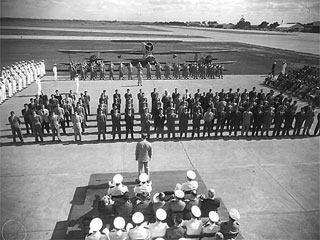
Citations:
- Wilson, Captain Barbara A., USAF (Ret), Women in World War II. Captain Barbara A. Wilson, USAF (Ret), 1996-2007.
- Wilson, Captain Barbara A., USAF (Ret), Women in World War II - They Also Served. Captain Barbara A. Wilson, USAF (Ret), 1996-2007.
- Women & the U.S. Navy: World War II Era WAVES. Department of the Navy, Naval Historical Center, 2001-2005.
- Thomson, Robin J., USCG, SPARS: The Coast Guard & the Women's Reserve in World War II. The U.S. Coast Guard.
- Sturkey, Marion F., Women Marines. Reprinted from: Warrior Culture of the U.S. Marines, 2001.
- Parrish, Nancy, Editor, WASP [Women Airforce Service Pilots] - WWII. Wings Across America.
- Osman, Stephen E., Fort Snelling's Last War. Minnesota Historical Society: Minnesota's Greatest Generation, 2007.
- Military Intelligence Service Language School. Minnesota Historical Society: History Topics, 2007.
- The Manhattan Project: An Interactive History. US Department of Energy, Office of History and Heritage Resources, 2007.
- Ano, Masaharu, Loyal Linguists: Nisei of World War II Learned Japanese in Minnesota. Minnseota History. St. Paul, MN: Minnesota Historical Society, Vol. 45, No. 7, p. 273-287.
- The War Relocation Authority & the Incarceration of Japanese-Americans During World War II. Harry S. Truman Library and Museum, 2007.
- Research on 100th/442nd Regimental Combat Team. National Japanese American Historical Society, 2007.
- 100th Battalion, 442nd Infantry. Global Security, 2000-2007.
- The Civilian Conservation Corps Experience. Minnesota Historical Society: In Their Words: Stories of Minnesota's Greatest Generation, 2007.
- Camp Savage. Google Maps, 2007.
- Military Intelligence Service Language School at Fort Snelling. Minnesota Historical Society: Library: History Topics, 2007.
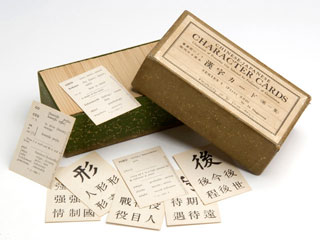 Object: Chinese-Japanese language character cards at Camp Savage during World War Two. Acc. no. 2005.58.1
Object: Chinese-Japanese language character cards at Camp Savage during World War Two. Acc. no. 2005.58.1
- Rosie the Riveter. Wikipedia.org, 2007.
- The American Red Cross in World War II. American Red Cross Museum, 2007.
 Photo: Thirty-six hundred student nurses inducted into cadet corps at Northrop Auditorium, 1943.
Photo: Thirty-six hundred student nurses inducted into cadet corps at Northrop Auditorium, 1943.- History of the Women's Army Corps. Women's Army Corps Veterans Association, 2004-2005.
- Bellafaire, Judith A., The Women's Army Corps: A Celebration of World War II Service. U.S. Army Center of Military History, 2005.
 Photo: WAC induction, Minneapolis Auditorium; Eleanor Roosevelt is present, 1943.
Photo: WAC induction, Minneapolis Auditorium; Eleanor Roosevelt is present, 1943.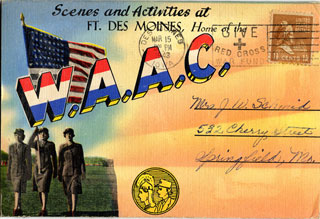 Document: WAAC Postcard Portfolio, Fort Des Moines, Iowa.
Document: WAAC Postcard Portfolio, Fort Des Moines, Iowa.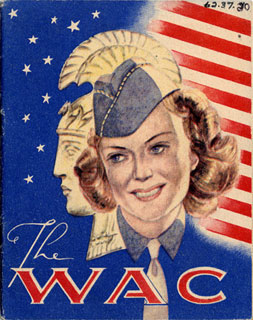 Document: Pamphlet: The WAC.
Document: Pamphlet: The WAC.- Women & the U.S. Navy: World War II Era WAVES. Department of the Navy, Naval Historical Center, 2001-2005.
- Great Lakes, America, and the Two-Ocean War, 1941-1943. Naval Station Great Lakes, Illinois, 2007.
- Women's Airforce Service Pilots. National Museum of the USAF, 2007.
- Women's Auxiliary Ferrying Squadron. National Museum of the USAF, 2007.
- Women's Flying Training Detachment. National Museum of the USAF, 2007.
- Thompson, Robyn J., USCG, SPARS: The Coast Guard and the Women's Reserve in World War II. Women & The Sea: The Mariner's Museum, 2001.
- Stremlow, Colonel Mary V. (Ret), Free A Marine to Fight: Women Marines in World War II. National Park Service: War In The Pacific - National Historical Park, Guam, 2007.
- Women Mariners in World War II. American Merchant Marine at War, 1998-2004.
- Hiroshima, Japan. Google Maps, 2007.
- Nagasaki, Japan. Google Maps, 2007.
- Jacob, Frances, Nervous in the Service, or 'Up and Atom.' Minnesota Historical Society Manuscripts Collection, [194-].
- Piccolo, Catherine Filippi, Catherine Piccolo Papers. Minnesota Historical Society Manuscripts Collection, 1942.
- Murikami, Anna Tanaka; Thomas Saylor, Interviewer, Minnesota's Greatest Generation Oral History Project, Thomas Saylor; Minnesota Historical Society Oral History Collection, 2003.
- Bill Amyotte; Karissa White and Brian Horrigan, Interviewers, Minnesota's Greatest Generation Oral History Project, Minnesota Historical Society Oral History Collection, 2006.
- Drouillard, Jim; Karissa White and Brian Horrigan, Interviewers, Minnesota's Greatest Generation Oral History Project, Minnesota Historical Society Oral History Collection, 2006.
- Bartlett, Wilbert LeRoy; Thomas Saylor, Interviewer, Thomas Saylor; Minnesota Historical Society Oral History Collection, 2002.
- Pearson, Charles M., Valedictory Address, Dartmouth College, May 10, 1942. Curtis Pearson, used with permission.
- Minnesota World War II Memorial. Minnesota Department of Veterans Affairs, 2007.


